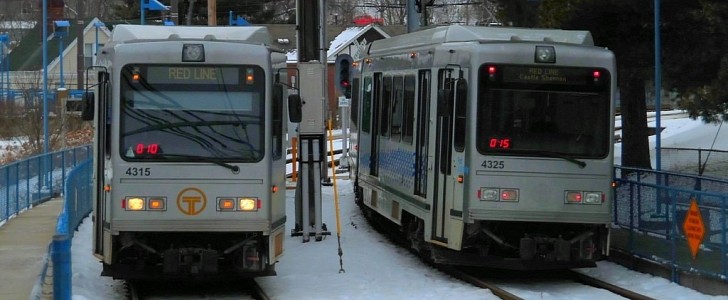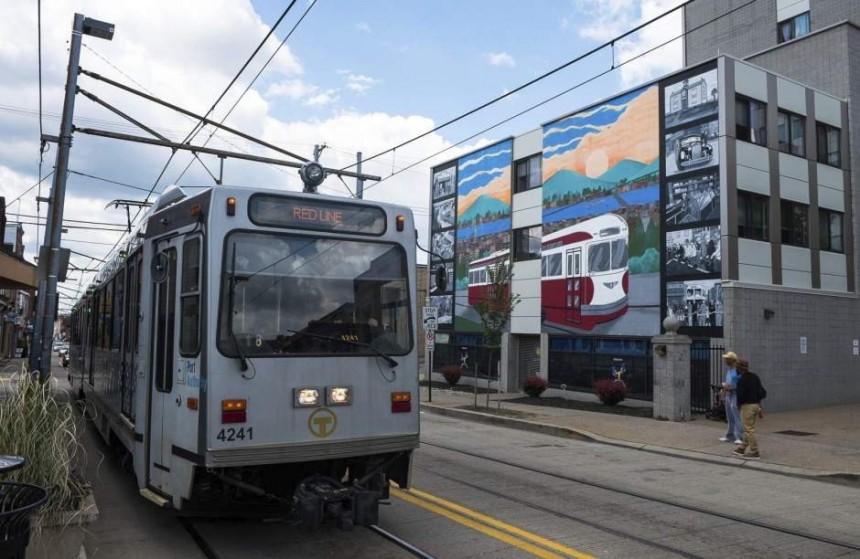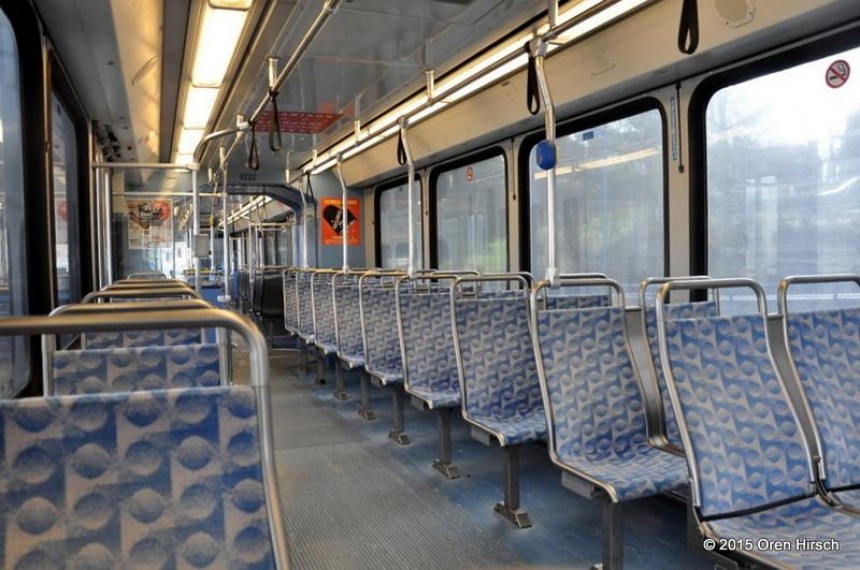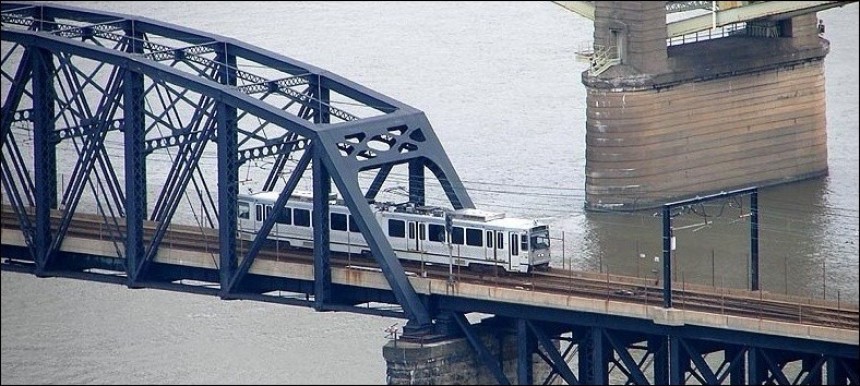Is it a train, a tram, or a case of "honey, I shrunk the New York Subway?" Whatever you decide to call it, this is what passes for a mass transit system in one of America's lesser celebrated major cities.
Say hello to Pittsburgh's Light Rail Network, better known as "the T" by the locals. While other cities in the region like Philadelphia and New York City are famous for some of the most developed rail transit in the world, this is what the fine folks of Western Pennsylvania get instead.
A system with trains a meager two cars long and only 26.2 miles (42.2 km) of rail tracks for a commuter population of around 25 thousand people per day. All situated in between Downtown Pittsburgh and the bordering South Hills suburbs.
So what gives? Why is a major city within driving distance of Philadelphia, Chicago, and New York City stuck with such a sub-par rail system? The answer to that is complicated. It involves politics, city accountants, and lots and lots of boring city hall meetings. But to cut through 99% of the boring gristle here's what happened.
In the old days, Pittsburgh utilized a mass transit system more akin to a medium-sized European city like Barcelona or Paris instead of a small American one. Pittsburgh's streetcar (tram) system was once the envy of any global city. It ferried city workers to work the bustling industrial centers and financial institutions that once fueled Pittsburgh to global city status on the same footing as Boston or New York.
That was ever such a long time ago, though. By the mid-1980s, Pittsburgh's once iconic electric streetcars were gone. In their place was increased auto traffic and something Pittsburgh natives like to call the T. Now, is the T a traditional subway, a commuter light rail system, or a glorified trolley? Well, that's somewhat hard to distinguish, as the T has elements of all three.
Unlike New York or Chicago, Pittsburgh's Light Rail uses sections of the old PGH Trolley lines connected to major rail thoroughfares that lead to stations through Pittsburgh's South Hills neighborhoods. In these sections, the T has dedicated right of way privileges along the route. As the train approaches Downtown Pittsburgh from the South, it transitions to operating as a deep-level subway.
As for the train cars, they're pretty neat in themselves. They're SD-400 train cars, designed by the famed Siemens Mobility company just before the end of the Cold War. The cars run on 5 ft 4.5 in (1,638 mm) gauge tracks instead of the industry standard 4 ft 8.5 in (1,478 mm). They're powered via a 650 volt DC electrical system sustained via overhead powerlines across the route.
When stepping onto a Pittsburgh T train, be it the Red, Blue, or Silver line, you're immediately hit with the sheer lack of scale many urbanites are familiar with when it comes to mass transit. The metal seats inside are at least trimmed with a soft touch cloth material that makes a 20 minute or so commute from the South Hills into downtown Pittsburgh a bit less painful. Scanning your ticket like a city bus sure does blend the line between a trolley and a full-on commuter train.
Push-to-stop buttons are located in the front and rear of each car, allowing an express train to become a local train at just the push of a button. All Pittsburgh T cars were refurbished in the mid-2000s by Construcciones y Auxiliar de Ferrocarriles (CAF). A company specializing in building and maintaining light rail equipment based out of Spain but operating around the world.
Considering some public transit networks haven't received a major update for decades now, it makes the Pittsburgh T at least look aesthetically pleasing. Sadly, that won't compensate for the T's chronic lack of access to places outside of the South Hills. Unlike other major commuter rail networks like SEPTA, the Long Island Railroad, and so on, the T is only accessible in a handful of Pittsburgh suburbs on the South Hills.
Access to areas north of Pittsburgh's three rivers is not currently possible by means other than a car or bus. Sadly, this is a trend that largely began with the retirement of the old Pittsburgh electric streetcars over 50 years ago. As more and more of Pittsburgh's working-class dedicated their commutes to their cars, there's been less and less need to bother spending taxpayer money on new T extensions.
Thus, the T and its adorable little fleet of two-car trains have become mostly reserved for wealthy doctors, bankers, and business people who use it as their personal chauffeur between their offices downtown to their mansions back home. Now, you may ask yourself what good any public rail system is if only a select handful of residents have any use for it? To that, we can't provide a satisfactory answer. At least they're electric vehicles and don't pollute.
Check back for more from EV month here on autoevolution.
A system with trains a meager two cars long and only 26.2 miles (42.2 km) of rail tracks for a commuter population of around 25 thousand people per day. All situated in between Downtown Pittsburgh and the bordering South Hills suburbs.
So what gives? Why is a major city within driving distance of Philadelphia, Chicago, and New York City stuck with such a sub-par rail system? The answer to that is complicated. It involves politics, city accountants, and lots and lots of boring city hall meetings. But to cut through 99% of the boring gristle here's what happened.
In the old days, Pittsburgh utilized a mass transit system more akin to a medium-sized European city like Barcelona or Paris instead of a small American one. Pittsburgh's streetcar (tram) system was once the envy of any global city. It ferried city workers to work the bustling industrial centers and financial institutions that once fueled Pittsburgh to global city status on the same footing as Boston or New York.
Unlike New York or Chicago, Pittsburgh's Light Rail uses sections of the old PGH Trolley lines connected to major rail thoroughfares that lead to stations through Pittsburgh's South Hills neighborhoods. In these sections, the T has dedicated right of way privileges along the route. As the train approaches Downtown Pittsburgh from the South, it transitions to operating as a deep-level subway.
As for the train cars, they're pretty neat in themselves. They're SD-400 train cars, designed by the famed Siemens Mobility company just before the end of the Cold War. The cars run on 5 ft 4.5 in (1,638 mm) gauge tracks instead of the industry standard 4 ft 8.5 in (1,478 mm). They're powered via a 650 volt DC electrical system sustained via overhead powerlines across the route.
When stepping onto a Pittsburgh T train, be it the Red, Blue, or Silver line, you're immediately hit with the sheer lack of scale many urbanites are familiar with when it comes to mass transit. The metal seats inside are at least trimmed with a soft touch cloth material that makes a 20 minute or so commute from the South Hills into downtown Pittsburgh a bit less painful. Scanning your ticket like a city bus sure does blend the line between a trolley and a full-on commuter train.
Considering some public transit networks haven't received a major update for decades now, it makes the Pittsburgh T at least look aesthetically pleasing. Sadly, that won't compensate for the T's chronic lack of access to places outside of the South Hills. Unlike other major commuter rail networks like SEPTA, the Long Island Railroad, and so on, the T is only accessible in a handful of Pittsburgh suburbs on the South Hills.
Access to areas north of Pittsburgh's three rivers is not currently possible by means other than a car or bus. Sadly, this is a trend that largely began with the retirement of the old Pittsburgh electric streetcars over 50 years ago. As more and more of Pittsburgh's working-class dedicated their commutes to their cars, there's been less and less need to bother spending taxpayer money on new T extensions.
Thus, the T and its adorable little fleet of two-car trains have become mostly reserved for wealthy doctors, bankers, and business people who use it as their personal chauffeur between their offices downtown to their mansions back home. Now, you may ask yourself what good any public rail system is if only a select handful of residents have any use for it? To that, we can't provide a satisfactory answer. At least they're electric vehicles and don't pollute.









